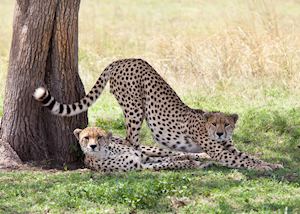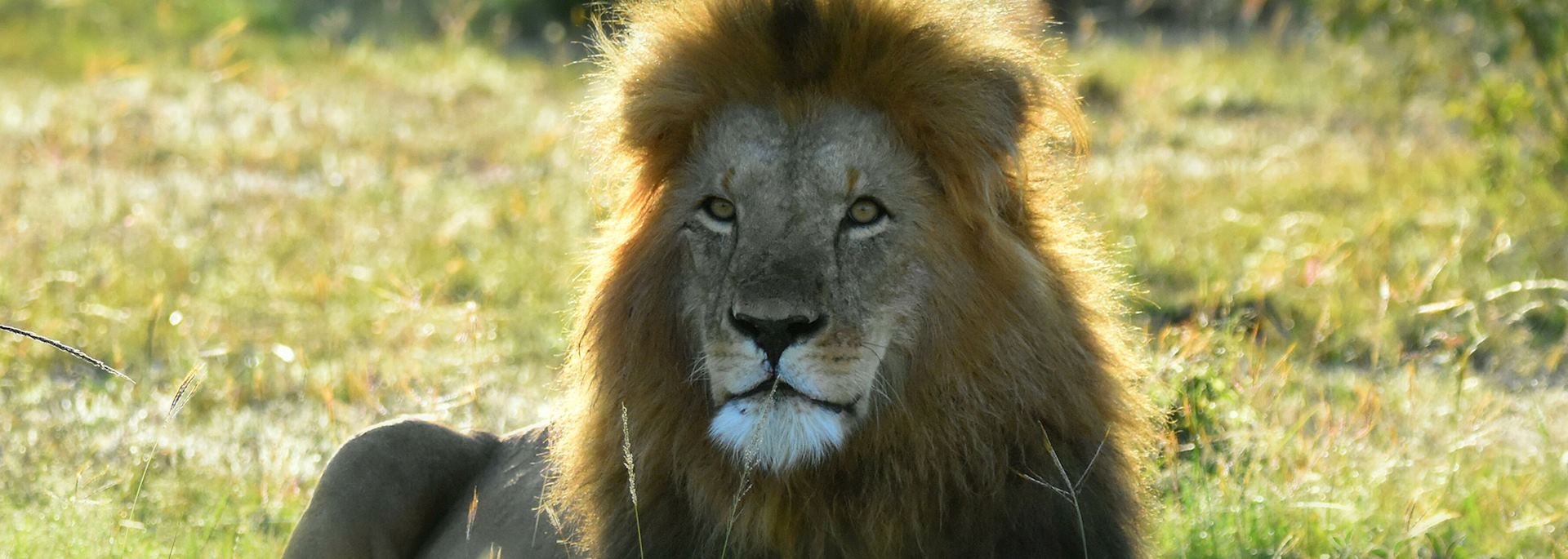Jump to:
Lion battling for territory, rutting and grunting wildebeest flooding the plains and hyena packs whooping their whereabouts under cover of darkness. Spend just a short time in the Mara Naboisho Conservancy and you soon forget there’s a world beyond the animal kingdom.
Naboisho means ‘coming together’ in the Maa language, symbolic of the 500 Maasai landowners who joined to contribute land for the conservancy’s creation. The result? A large area of grassy plains and rocky hills on the eastern edge of the Masai Mara National Reserve that has become a haven for animals big and small, while also benefiting local communities.
The Mara Naboisho Conservancy is the second largest of the Greater Mara’s conservancies, and one of the most beautiful. The Ngama Hills rise in the distance, streams run across the open grassland and acacia trees dot the landscape, some showing tell-tale signs that elephant have recently passed through.
The conservancy is probably best known for its big cats, particularly lion, with a pride of around 20 (the largest in the Greater Mara region) roaring, prowling and snoozing their way through the land. This doesn’t put other wildlife off, and you’ll see large numbers of wildebeest, twitchy Thomson’s and Grant’s gazelles, topi (which are only found in the Masai Mara and the Serengeti) and dazzles of zebra populating the plains as you explore on game drives.
 With the help of experienced guides, many of whom were born and raised in the area, you also have a good chance of seeing elephant, Masai giraffe and cheetah on your twice-daily game drives. The conservancy covers a migratory corridor between the main Masai Mara National Reserve and the Loita Plains, allowing hundreds of thousands of animals to continue their natural migratory patterns.
With the help of experienced guides, many of whom were born and raised in the area, you also have a good chance of seeing elephant, Masai giraffe and cheetah on your twice-daily game drives. The conservancy covers a migratory corridor between the main Masai Mara National Reserve and the Loita Plains, allowing hundreds of thousands of animals to continue their natural migratory patterns.
A safari here feels more exclusive than in the main reserve. Fewer camps means fewer visitors, so you’re unlikely to see many other vehicles while out and about. And, just four vehicles are permitted at any wildlife sighting, ensuring animals remain undisturbed and your safari experience isn’t tainted by big crowds.
Staying in a conservancy rather than the main reserve has other advantages, too. You have a wider choice of activities here, including bush walks that focus on interpreting animal tracks, listening to and identifying birds, finding out the different uses Maasai have for local plants and zooming in on smaller creatures such as insects and reptiles.
Game drives can continue after dark, giving you a chance to see nocturnal species such as bush babies, African hares, bat-eared foxes, nightjars and predators on their night-time hunt. And, your vehicle is able to go off-road to follow (from a respectful distance) big cats and other wildlife you come across.
The conservancy fees from your stay are fed back into the local Maasai communities, providing them with an income and improved education and healthcare. This not only ensures a sustainable livelihood, but also provides the Maasai with an incentive for conserving wildlife.
The communities are also permitted to graze cattle on the land. You might see Maasai men and women herding sheep, goats and cows as you venture through the conservancy. It’s a reminder of how humans and wildlife are interlinked and the importance of living harmoniously for the benefit of all.
Best time to visit Mara Naboisho Conservancy
You’ll see plenty of wildlife whatever time of year your travel, but wildebeest numbers skyrocket during the Great Migration, which usually occurs between July and October. You’re most likely to experience rain between March and May, but it shouldn’t impact on your safari experience and you’ll see fewer other visitors at this time.
who's been there

Start planning your tailor-made trip to Mara Naboisho Conservancy by contacting one of our Kenya specialists
-
617-223-4521617-223-4534
- Make an inquiry
Suggested itinerary featuring Mara Naboisho Conservancy
This sample itinerary will give you an idea of what is possible when you travel in Mara Naboisho Conservancy, and showcases routes we know work particularly well. Treat this as inspiration, because your trip will be created uniquely by one of our specialists.
Places near Mara Naboisho Conservancy
- Mara North Conservancy 18 miles away
- Masai Mara National Reserve 26 miles away
- Loita Hills 39 miles away
- Shompole Magadi 75 miles away
- Lake Naivasha 84 miles away
- Lakes of the Great Rift Valley 90 miles away
- Lake Nakuru 90 miles away
- Nairobi 104 miles away
- Lake Victoria 111 miles away
- Ol Pejeta Conservancy 148 miles away
- Sosian Lodge 151 miles away
- The Laikipia Plateau 151 miles away
- Amboseli National Park 152 miles away
- Loisaba Wilderness Conservancy 179 miles away
- Ol Lentille Conservancy 182 miles away
- Il Ngwesi Group Ranch 183 miles away
- Lewa Wilderness Conservancy 186 miles away
- The Chyulu Hills 192 miles away
- Borana Ranch 193 miles away
- Karisia Hills 200 miles away
- Samburu National Reserve 207 miles away
- Meru National Park 224 miles away
- Matthews Mountain Range 226 miles away
- The Parks & Reserves of Northern Kenya 227 miles away
- Shaba National Reserve 227 miles away
- Tsavo West National Park 230 miles away
- The Parks & Reserves of Southern Kenya 255 miles away
- Tsavo East National Park 259 miles away









